ENGLISH PERIODS & STYLES OF THE SEATS AND ITS PETIT POINT COVERING
GOTHIC (1066-1509) 443 years
PLANTAGENET


Stephen (Etienne) 1135-1154
Henry II 1154-1189

Crusade 1189
Early English
Richard I 1189-1199
Jean (sans terre)1199-1216
Henry III 1216-1272
Edouart I 1272-1307

Early (true)
Edouart II 1307-1327

Edouart III 1327-1377
Richard II 1377-1399
Henry IV 1399-1413
Henry V 1413-1422
Henry VI 1422-1461
Edouart IV 1461-1483
Richard III 1483-1485
Edouart V 1470-1483
RENAISSANCE (1485-1603) 118 years
TUDOR


Yeoman
Henry VII 1485-1509


Henry VIII 1509-1547
Edouart VI 1547-1553
Mary I 1553-1558

Elizabeth 1558-1603
Elizabethan
1485- Yeoman is any of the undred men of the guard for the royal familly institued by Henry VII in 1485. It is given too this name to the style of the furnitures of that reign.

XVIIth CENTURY
STUART


Jacobean
James I 1603-1625

Charles I 1625-1649
Revolution
Cromwell 1650-1658
Richard (Cromwell's son)
Restauration
Charles II 1660-1685
James II 1685-1689

Orange
William III (of Orange)
& Mary II 1689-1702
& Mary II 1689-1702
1603- Jacobean. First trip of Inigo Jones to Roma. Appearance of bulbous leg used on tables or as balusters to cupboards or bedsteads.

XVIIIth CENTURY
HANOVRE


Georges I 1714-1727
Georgian
William Kent
Georges II 1727-1760

Chippendale
Georges III 1760-1820
Adam & Hepplewhite
Sheraton
XIXth CENTURY
XXth CENTURY
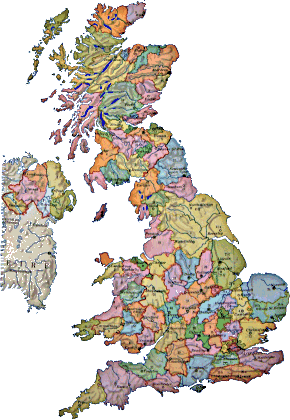
Seats where since long a simple chest which
 was used to stock necessaries stuff. The only comfort was a cussion upon it. The domestic chair was almost unknown, the stool and the bench was the usual seats.
was used to stock necessaries stuff. The only comfort was a cussion upon it. The domestic chair was almost unknown, the stool and the bench was the usual seats.
 was used to stock necessaries stuff. The only comfort was a cussion upon it. The domestic chair was almost unknown, the stool and the bench was the usual seats.
was used to stock necessaries stuff. The only comfort was a cussion upon it. The domestic chair was almost unknown, the stool and the bench was the usual seats.
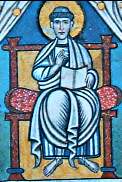
Gospel collection from south east England called Codex Aureus. VIIIth century
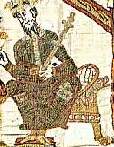
Edouard the confessor sends Harold to inform William duke of Normandie that he will succeed to the throne of England. Bayeux tapestry XIth c.
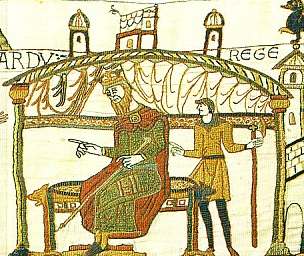
Edouard the confessor listens to Harold reporting on his mission to Normandy. (notice the cushion covering the bench)

From semi-circle, side by side, then intersecting one we obtain in the interlacing the pointed arch of the gothic.

Sutton courtney churc, Berkshire. Transitional norman.
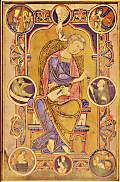
Liessies's gospel painted by Lambeth arround 1146
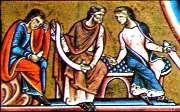

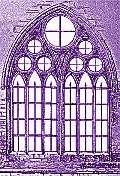
Geometrical tracery without cusping. Thirteenth century, Raunds, Northamptonshire.
Above right hand side the Utrecht's psalter painted in late twelfth century.
Chair long retained something of their early value as status symbols; so stools so long remained the most readily available seating - in the kitchen regions the simple three-legged stick stool, and for diners the stools, joint stools or benches.
Chair long retained something of their early value as status symbols; so stools so long remained the most readily available seating - in the kitchen regions the simple three-legged stick stool, and for diners the stools, joint stools or benches.
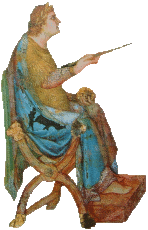

Egytian divinity resting on an X-style chair. (Notice the head of the lion on the covering and the lion's paw and ball legs.)
Period from Crusade to late thirteenth century were of dissemination of decorating ideas but it took time to adopt them in England country. Right hand side a painting on wall dated 1315-1320 from Assise's basilique

Crowning throne build in 1308th c Westminster abbey.
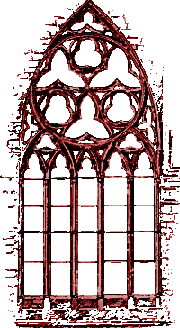
Geometrical tracery with cusping. Chapter house, York 13th.c
Untill the later years of the thirteenth century the art and methods of the furniture maker were copied faithfully from stone-mason. Up to the middle of the thirteenth the carpenter was the sole craftman in wood. The persistence of constructive methods is found to much later periods than one would expect.
Cultured Gothic furniture, from early times up to the monasteries dissolution, is pratically non-existent. Only such examples can be found as the Guild chair in St. Mary's Hall at Conventry or as the Crowning throne above.
Cultured Gothic furniture, from early times up to the monasteries dissolution, is pratically non-existent. Only such examples can be found as the Guild chair in St. Mary's Hall at Conventry or as the Crowning throne above.
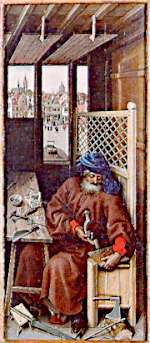
Robert Campin the Master Flemalle triptych "from Merode" Saint Joseph; painting on wood around 1425; New York, the Metropolita, museum of art, the closter collection.
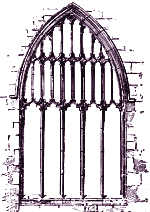
Perpendicular tracery of late fifteenth century. Swinbrook church, Oxfordshire.
It is impossible to apprehende the furniture and woodwork of this time without a proper appreciation of Gothic building, to which the style properly belongs.
Gothic ornament, right up to the middle of the fourteenth century is constructive ornament where the details of construction are given ornemental forms.
Gothic ornament, right up to the middle of the fourteenth century is constructive ornament where the details of construction are given ornemental forms.
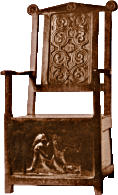
Armchair Box XVIth.c.Toronto Museum
Before seventeenth century as chest with back and arms, chair started out. They had cloths thrown over them for decoration and warmth; cushions were used to soften the hard seat. This is where needlework and canvaswork enters the picture.
The Yeoman style
The Renaissance really begins, in England, with the accession of Henry VIII in 1509.
The constructive ornament, which is an integral element of Gothic period, has already lost many of its early principle. In Gothic period the silhouette of ornament had the decorative value. With the Renaissance it is the ornament which has the decorative value.
The monasteries post-dissolution woodworker had become utterly depraved; the flower of the craft had turned to the new maner, the Renaissance, the new style from France and Italy. Onward will come the time of the prevalence and influence of fashion.
The constructive ornament, which is an integral element of Gothic period, has already lost many of its early principle. In Gothic period the silhouette of ornament had the decorative value. With the Renaissance it is the ornament which has the decorative value.
The monasteries post-dissolution woodworker had become utterly depraved; the flower of the craft had turned to the new maner, the Renaissance, the new style from France and Italy. Onward will come the time of the prevalence and influence of fashion.
For these chairs, cushions of rich fabric were often embroidered. The design were generally floral, simply shaded, and rather symmetrical.
 Above a detail of the foot stool covering from The family of Henry VIII at Witehall palace (1545)
Above a detail of the foot stool covering from The family of Henry VIII at Witehall palace (1545)

MARY AND THE BEGINNING OF THE ELIZABETHAN STYLE
Since Henry VIII craftsmen from Holland, France and Italy were encouraged to settle in England.
Stools and forms develop side by side with chairs, changing from the box or the end-trestle form to four legged type.
To the XVIth century a chair was something of a status symbol whereas most of the household and staff were served by well-cushioned wall benches, settles and easily shifted stools. The English adapted the French caquetoire (gossip's chair) to their needs. Cushions were now a real necessity for the hard wooden chair.
Furniture, jewelry and clothing became much more elaborate. Cushions were an other symbol of prosperity and luxury. Listed as cushyns, cosshens, quitions, kussons etc. they occurs frequently in inventories and records. The tent stitch was used so much for cushions that this type of embroidery was known as cushions work.
In 1543 Princess Mary Tudor gave her father Henry VIII a chair which cost about �4, but the needlework no less than �18.
Later Mary Stuart queen of Scotland and France was stitching during council. Young girl she had the benefit of a sound training in needlework at the French court and was no doubt taught with the other princess by their mother, Catherine de Medici. Queen Catherine was herself an expert, having learned the art at a couvent in Florence. When Mary Stuart returned to Scotland she brought certain French servants with her including an embroiderer, Pierre Oudry. Pierre Oudry was a portrait painter but he also prepared needlework, drawing the designs and doing preparatory outlining in black silk.
Escaping from Lochleven, Mary Stuart fled to England. In following year (1569) her semi-emprisonment led by fortunate chance to a great needleworking partnership between Mary and her custodian's wife, Elizabeth Shrewsbury otherwise known as Bess of Hardwick.
Stools and forms develop side by side with chairs, changing from the box or the end-trestle form to four legged type.
To the XVIth century a chair was something of a status symbol whereas most of the household and staff were served by well-cushioned wall benches, settles and easily shifted stools. The English adapted the French caquetoire (gossip's chair) to their needs. Cushions were now a real necessity for the hard wooden chair.
Furniture, jewelry and clothing became much more elaborate. Cushions were an other symbol of prosperity and luxury. Listed as cushyns, cosshens, quitions, kussons etc. they occurs frequently in inventories and records. The tent stitch was used so much for cushions that this type of embroidery was known as cushions work.
In 1543 Princess Mary Tudor gave her father Henry VIII a chair which cost about �4, but the needlework no less than �18.
Later Mary Stuart queen of Scotland and France was stitching during council. Young girl she had the benefit of a sound training in needlework at the French court and was no doubt taught with the other princess by their mother, Catherine de Medici. Queen Catherine was herself an expert, having learned the art at a couvent in Florence. When Mary Stuart returned to Scotland she brought certain French servants with her including an embroiderer, Pierre Oudry. Pierre Oudry was a portrait painter but he also prepared needlework, drawing the designs and doing preparatory outlining in black silk.
Escaping from Lochleven, Mary Stuart fled to England. In following year (1569) her semi-emprisonment led by fortunate chance to a great needleworking partnership between Mary and her custodian's wife, Elizabeth Shrewsbury otherwise known as Bess of Hardwick.
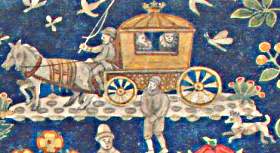
That part of the design is evidently based on an illustration of Queen Elizabeth's coach in Braun. (Civitates Orbis Terrarum 1512)
ELIZABETHAN
As a general rule , once a defined fashion exists, everything made at that time conforms to the mode of its period.
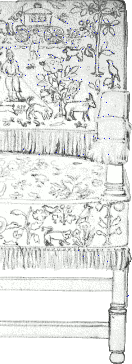
Walnut begins now to be sparingly used (Juglans regia appears to have been first planted at Wilton Park by the earl of Pembroke and Montgomery during middle of XVIth ceentury). As seen the secular chair is late arrival; it remains up to second half of the sixteenth century in the form of a panelled box, with back and arms. The alteration from this form where the back is mounted on a stool almost coincides with the dawn of the seventeenth century.
In XVIth century west european countries are in such interconnection that style of life, taste and idea takes very few time to be, though timidly, adopted by England. Near the end of her reign Elizabeth Ist chartered the East India Co. to begin trade with India. So began importation of the printed and painted cottons, the Indian Palampores, wich will have a great influence on the decorating paterns in the next centuries.

Sketch from an armchair in Hardwick Hall belonging to the duke of Devonshire. (3'.6"H 2'.6"W)
The knotted serpent has been omitted in the coloured sketch is the badge of the Cavendish familly to which the Duke of Devonshire belongs.
The knotted serpent has been omitted in the coloured sketch is the badge of the Cavendish familly to which the Duke of Devonshire belongs.
Walnut begins now to be sparingly used (Juglans regia appears to have been first planted at Wilton Park by the earl of Pembroke and Montgomery during middle of XVIth ceentury). As seen the secular chair is late arrival; it remains up to second half of the sixteenth century in the form of a panelled box, with back and arms. The alteration from this form where the back is mounted on a stool almost coincides with the dawn of the seventeenth century.
In XVIth century west european countries are in such interconnection that style of life, taste and idea takes very few time to be, though timidly, adopted by England. Near the end of her reign Elizabeth Ist chartered the East India Co. to begin trade with India. So began importation of the printed and painted cottons, the Indian Palampores, wich will have a great influence on the decorating paterns in the next centuries.
Pattern books just for the embroiderer were published on the continent in the last quarter of the sixteenth century. One of the best known was Jacques Lemoine de Morgue's La clef des champs published in France in 1586.
Occasionally topical events were embroidered. A panel, probably for a cushion, in the Lady Lever Art Galery commemorates a safe delivrance following the Armada and the Gunpowder Plat. As a young girl, Elizabeth I made a cushion for her governess in silk and wool in tent and cross stitches. In 1598 Paul Hentzner, a recorder of his travel, noted seing at Windsor Castel a cushion most curiously wrought by Elizabeth own's hand. A nice cushion in Cogenhoe Church, Northamptonshire, of about 1600, depicts flower slips within an interlacing knot pattern, with a red scale pattern border.
Occasionally topical events were embroidered. A panel, probably for a cushion, in the Lady Lever Art Galery commemorates a safe delivrance following the Armada and the Gunpowder Plat. As a young girl, Elizabeth I made a cushion for her governess in silk and wool in tent and cross stitches. In 1598 Paul Hentzner, a recorder of his travel, noted seing at Windsor Castel a cushion most curiously wrought by Elizabeth own's hand. A nice cushion in Cogenhoe Church, Northamptonshire, of about 1600, depicts flower slips within an interlacing knot pattern, with a red scale pattern border.
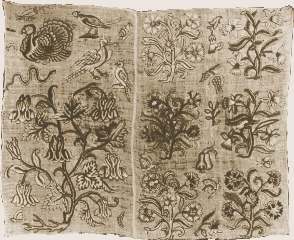
JACOBEAN

James Ist. armchair. Seat covered with coarse canvas work known as Turkey work
English furniture work, weither of the sixteenth or the seventeenth century, varies little, if at all. There remain only construction and proportion.
We already found, in inventories of the sixteenth centuries, chairs as turneyed chairs. Copies made in the seventeenth century, on the orher hand, are note unusual. Untill 1620s the design consists of heavy framed up panelling, the back stiles being extended to support the solid panelling of the back. The seventeenth century chairs are nearly always made from fruits-woods, pear, apple, plum or damson.
We already found, in inventories of the sixteenth centuries, chairs as turneyed chairs. Copies made in the seventeenth century, on the orher hand, are note unusual. Untill 1620s the design consists of heavy framed up panelling, the back stiles being extended to support the solid panelling of the back. The seventeenth century chairs are nearly always made from fruits-woods, pear, apple, plum or damson.
An increase in comforts in the seventeenth century called for further upholstery. The Countess of Salisbury had a set made professionally in time for the birth of her daughter in 1612 which were said to have cost a fortune.
Tapestry were now widely produced in many European countries for palaces and great houses. James Ist founded the Mortlake factory near London in 1613 and encouraged the planting of mulberry trees to stimulate the silk indutry. The factory had a short but positive influence on other English textiles, especially since both the designs and the workers were introduced from abroad.
The Embroideries and materials became much more sumptous. Its is most probable that needlework is, at the time, purely an amateur, or home art, although there are some evidences to show that Carolean ladies were thaught by migrating teachears or professors. They developed a taste for plain silk costly and beautiful. No doubt there was considerable fashionable femal rivalry to possess the finest work-casket.
Women made sure that their daughters were studious in embroideries discipline and training, to inherit from them as many skills and stitches as they knews. From a Farthingale chair in possession of the Duke of devonshire in Harwick Hall, Derbyshire. The original is embroidered on canvas and applied to black velvet.
From a Farthingale chair in possession of the Duke of devonshire in Harwick Hall, Derbyshire. The original is embroidered on canvas and applied to black velvet.
Tapestry were now widely produced in many European countries for palaces and great houses. James Ist founded the Mortlake factory near London in 1613 and encouraged the planting of mulberry trees to stimulate the silk indutry. The factory had a short but positive influence on other English textiles, especially since both the designs and the workers were introduced from abroad.
The Embroideries and materials became much more sumptous. Its is most probable that needlework is, at the time, purely an amateur, or home art, although there are some evidences to show that Carolean ladies were thaught by migrating teachears or professors. They developed a taste for plain silk costly and beautiful. No doubt there was considerable fashionable femal rivalry to possess the finest work-casket.
Women made sure that their daughters were studious in embroideries discipline and training, to inherit from them as many skills and stitches as they knews.

RESTAURATION
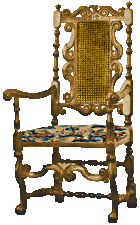
Walnut Charles II chair (1680) with the Flemish curve and the Low Country outward throw of the arms.
The new wood soon inaugurate a rapid developement in style. Shortly after 1670 we find details from Spain, Portugal, France and low Countries. All introduce original manner as the Spanish curled foot and bow stretcher, the Portugese bulb (wich develops rapidly into the inverted cup), the French palmette and Palmer's shell, and the Flemish C- and S-scrolls. Here, as in many armchair, weight is reduced by confining the back support to a panel at about shoulder height. This left space for a deep cushion. Chair showed a change of stretcher arrangment, the legs being linked by two stretchers each side, one at the back and, at the front, an increasingly decorative member, turned or extensively carved which, instead of being tenoted between the front legs, is placed lower down between the cross-rail wich tie the front and the back legs together. In further stage the entire stretcher is placed flat, uniting all four legs in the form of a wavy X.
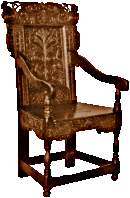
After Louis XIVth (the Sun King) had revoked the edict of Nantes in 1685 Huguenot craftmen fled France thus spreading French ideas and taste into Holland, England and even America. There was an embroidery workshop at Gobelins directed by Philibert Balland and a school to saint Cyr both leading the needle work art at its top level. James II ordered a bed, two armchairs and six stools to be made in Paris by Simon Delobel at a cost of �1 515.
This was a great period for needlework in England. Gros point, Petit Point, cross stitch and Queen (Rococo) was profusely used for seat covering.
Many new pattern books were now available to inspire embroiderer, and artist were called upon to transcribe designs. Variety of fruit, flowers and creatures was intended for cutting out and applying to. Animals and very large fanciful birds were introduced into the designs.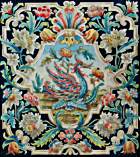



Oak chair from Thorpe Arch Hall, dated 1682, right in the walnut years. V.&A. museum
After Louis XIVth (the Sun King) had revoked the edict of Nantes in 1685 Huguenot craftmen fled France thus spreading French ideas and taste into Holland, England and even America. There was an embroidery workshop at Gobelins directed by Philibert Balland and a school to saint Cyr both leading the needle work art at its top level. James II ordered a bed, two armchairs and six stools to be made in Paris by Simon Delobel at a cost of �1 515.
This was a great period for needlework in England. Gros point, Petit Point, cross stitch and Queen (Rococo) was profusely used for seat covering.
Many new pattern books were now available to inspire embroiderer, and artist were called upon to transcribe designs. Variety of fruit, flowers and creatures was intended for cutting out and applying to. Animals and very large fanciful birds were introduced into the designs.


Complicated floral designs surrounding panels of landscapes or allegorical scenes are the fashion of the late Restauration period.

ORANGE
Since the accession of Charles II to that of Anne, the craft of chair maker was the most advanced in design, in methode and in rapidity of evolution. Fashion succeed each other, often within the space of few years, and we get several distinctive types even in the four's years reign of James II.
The Netherland influences evidently predominate under William of Orange but shall be really more marked in the reign of the last of the Stuarts.
 Elaborate walnut armchair in Petit Point needlework. Note the flat, wavy X stretcher tying all four legs. 1690-1695
Elaborate walnut armchair in Petit Point needlework. Note the flat, wavy X stretcher tying all four legs. 1690-1695
Although in embryonic form in the Orange period, the cabriole leg shall mark the dawn of the eighteenth century.
It is known that Queen Mary herself embroidered crewel coverings for chairs and stools. Celia Fiennes in the eighteenth century visited Windsor Castle and noted: hangings, chairs, stools and screen the same, all of satten stitch done in worsteads, beast, birds, ymages and ffruites all wrought very finely by Queen Mary and her maids of honour.
QUEEN ANNE
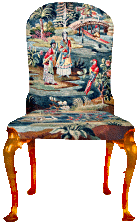 The smooth cabriole at its best. A chair of beautiful Chinese style design. 1705
The smooth cabriole at its best. A chair of beautiful Chinese style design. 1705
Since appearing circa 1670 the Portuguese bulb of the foot has developed its own English form as in a first steep an inverted cup and then in the most satisfactory Club or Pad-foot. The next is the well-known Ball-and-Claw. That form is said to have been borrowed from the chinese dragon-foot grasping a pearl.
The treatment of the knee also undergoes a rapid evolution and develops from the S-scroll of the previous reign in the perfect uncarved smooth cabriole which then passes through all ornamentations until it reachs acanthus decoration which we will found still into the period of Chippendale.
The chair back is now defined into side baluster and central splat. The seat lost its square look, becoming rounded or serpentine and verticals arm set back a little from the chair front to suite ladies's dresses.

Queen Anne sofa covered with imported needlepoint from Paris depicting exotic chinoiserie figures within iregular macarons.
EARLY GEORGIAN
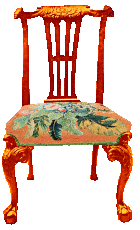 A fine example of a walnut side chair in the early mahogany years, illustrating the fashion of paper-scrolling the junction of top rail and side balusters and the cresting up of the legs over the seat-framing.
A fine example of a walnut side chair in the early mahogany years, illustrating the fashion of paper-scrolling the junction of top rail and side balusters and the cresting up of the legs over the seat-framing.Covering is a wool embroidery worked in naturalistic flowers in satin stitch on an enterely worked rust-red ground.
Canvas work continued to make a major contribution to furnishings during the first half of the XVIIIth century. The embroiderers employed the same materials as in the earlier period: Canvas remained the basic one.
The English delight in isolated floral motifs during the early XVIIIth century. The dense leaf and tree patterns were appropriate for covering and cushion. Densely-packed floral surrounds is often used to frame the pictorial centres of seat furniture.
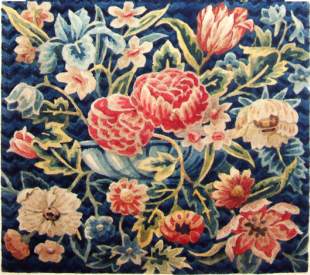 Original chair in Boughton House. Northamptonshire. From a chair belonging to the Duke of Buccleuch and covered in embroidered canvas
Original chair in Boughton House. Northamptonshire. From a chair belonging to the Duke of Buccleuch and covered in embroidered canvas
CHIPPENDALE
The terme Chippendale style indicates a school rather than a man. The Director is an expensive folio book of 160 plates published in 1754 in the form of a pre-paid subscription with the help of sponsors as the Duke of Beaufort, the Earl of Chesterfield, Lord Feversham, the Duke of Hamilton, the Duke of Norfolk, among others, and the Earl of Northumberland to who the book is dedicated.
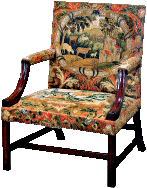 Mahogany Bergere armchair associated with Stowe, Buckinghamshire; simple but finely designed. Needlework depicts rural scene, framed in formal roundels.
Mahogany Bergere armchair associated with Stowe, Buckinghamshire; simple but finely designed. Needlework depicts rural scene, framed in formal roundels.
We only know the Chippendale style from the designs in the Director not from the work of Thomas Chippendale himself. That style includes not only the work of his contemporaries but much which was made before the time of the first edition of The Gentleman and Cabinet Maker's Director
In it we find lot of designs derived from French rocaille (rococo), English version of chinoiserie and Gothic (The Chinese trend was the rage of the early 1760s and was occasonally blended with rococo.) So the seat of the Chippendale style can be divided into four classes : The cabriole (merged into the French taste), the straigth-leg and fretted, the chinese and the Gothic.
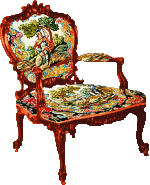 Mahogany armchair in the French manner of the Chippendale school. Seat and back are covered with fine canvas work depicting in Palladian style hero in a decorative framework .
Mahogany armchair in the French manner of the Chippendale school. Seat and back are covered with fine canvas work depicting in Palladian style hero in a decorative framework .
The Chippendale cabriole develops directly from the early mahogany years retaining the ball-and-claw but in a depraved maner. The scrolled or leaf-carved finish is the most usual, known at this time as the French foot.
The square-section leg (the section is more often triangular) belongs also to the Chippendale School, and is almost confined to it. We know that style of leg as Marlborough leg.
The rage for the Chinese taste was general and every designer pandered to it, not only in England but also in France. This fashion, appearing in late Stuart period, has probably been expanded by Sir William Chambers, who, published in 1757 Designs for Chinese Buildings and his precursor Mathias Darly with his Chinese, Gothic and Modern chairs published in 1752.
The Gothic vogue lasted just about ten years and was not as strong as were the French rococo and English chinoiserie. In circa 1760s, any piercing in the form of a pointed arch was hailed as Gothic
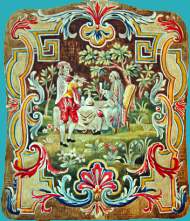 Back of an side chair in the French manner. (1750-5)
Back of an side chair in the French manner. (1750-5)
Needleworks is by nature elaborate and textured and therefore usually looks best on chairs of a simple line. Chippendale in his book recommended tapestry coverings or other sort of Needleworks for chair in the French style. Shops in London sold kits for milady to work, with the patern drawn on the canvas and the wools with which to work it included. Classical scenes continued to be a favorite design. Chair coverings of plainer forms, and in limited range of colours were also made. These sometimes imitated or echoed damask with bold formal leaf patterns in green, blue or red.
Nevertheless, though that the standard achieved by the amateur embroiderers throughout the last period was high, by the middle of the XVIIIth century they had confined themselves to heavy canvas work leaving to the professionals the high quality furnishing embroideries.
ROBERT ADAM & HEPPLEWHITE
In 1738 word of new excavations at Herculaneum and Pompeii reached the world. Whole room buried for centuries fascinated everyone, but it was not before 1760 that these discoveries affected the world of decoration.
 Sycomore armchair and inlay work in rosewood with characteristic lyre shaped back. An exeptionnal quality work from Adelphi foundation for Osterley Park library.
Sycomore armchair and inlay work in rosewood with characteristic lyre shaped back. An exeptionnal quality work from Adelphi foundation for Osterley Park library.
The drawings of Giambattista Piranesi published circa 1756 in Italia and in which he reproduced monument, ornemental motifs, vases etc. were undoubtly a great source of inspiration for a young man of 26 years old. Indeed it is in 1754 that Robert Adam commenced his Grand tour and did not return to England until 1758. He was there in Italy sketching and studying the works of ancient architecture. The result, in part, was a large folio volume with engravings by Bartolozzi and Piranesi himself, published in 1758.
Had the Adam style not existed the Cabinet Maker and Upholsterer's Guide of Hepplewhite would have been a very different production to what it is.
The symbols of ancient times were absorbed into the decorators' s catalogs and combined with symbols of the present. Indeed if we examine the Neo-Classical Adam style there is manifested a notable influence from outside.
 Gilded side chair with oval back and colone fluted leg. Adam c.1775. Professional French needlework with garlang and bunch of roses.
Gilded side chair with oval back and colone fluted leg. Adam c.1775. Professional French needlework with garlang and bunch of roses.
Adam chair were of painted or gilded soft wood with oval or rounded tapestry-mounted back, padded arm horizontals and tapering, fluted legs.
Dress fashion contributed to the shape: with stiffened coats and hooped skirts becoming outmoded during the 1760s, seats could be smaller and the arms brought forward over the front legs once more. The characteristic back outlines were the oval or rounded elipse; the nearly square escutcheon and the shield. Favorite decorations included delicate swags of flower, tripod urns, lunettes with radiating rays or fan and the lyre.
 Hepplewhite chair shield-back with triple baluster splats and Prince of Wales's feathers in center. Upholstered with canvas work of leafy plumes masterly shading.
Hepplewhite chair shield-back with triple baluster splats and Prince of Wales's feathers in center. Upholstered with canvas work of leafy plumes masterly shading.
George Hepplewhite died in 1786 and the first edition of the Guide has been issued in 1788 by the firm of A. Hepplewhite & Co. (the initial being that of the widow Alice an alteration of Aleas).
To the school of Hepplewhite belongs models borrowed from French Louis XV (curved or cabriole Hepplewhite) and Louis XVI (turned-leg Hepplewhite), at last the Taper-leg Hepplewhite which is merely the most original and representative of the work of this school. We must notice too, in the case of chairs, some distinctive characteristiques as the serpentine top-rail, the hoop-back (an almost revival of the earlier Queen Anne) and the shield-back in its various forms.
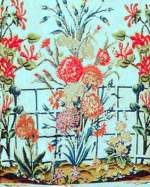 Second halh 18th century design with a realistic garden of different plants growing up a trellis.
Second halh 18th century design with a realistic garden of different plants growing up a trellis.
One hardly ever meets with a badly designed Hepplewhite chair. Hepplewhite school had a fine tradition behind it. Proportions and details were almost instintive. In the preface of the Guide the essence of Hepplewhite's style was stated as to combine elegance and utility.
The prefered upholstery materials for Adam-Hepplewhite were still tapestry or needlework but more yet figured silks and satins. Cushion continued to provide scope for needlework particularly for caned chair. Nevertheless Neo-classical embroidered coverings are relatively scarce. Simpler design in the style of the textile designer were increasingly preferred from about 1770. Combining silk weaving and embroidery they were often worked with tambour embroidery.
SHERATON
The revised edition of the Hepplewhite's Guide in 1791 included paterns for square-backed chairs which had been on the market for at least eight years before Sheraton in his The Cabinet Maker and Upholsterer's Drawing Book gave impetus to such designs in 1791.
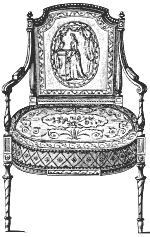 Drawing-room chair design by Thomas Sheraton. This illustrate the type of design Sheraton thought appropriate for upholstery.
Drawing-room chair design by Thomas Sheraton. This illustrate the type of design Sheraton thought appropriate for upholstery.
Late in XVIIIth and early XIXth century design reflected the archaeologist's wish to reproduce the actual furniture of the ancient Romans, Greeks and Egyptians. Thomas Hope, in 1807, rejoiced that the French Revolution had restored the pure taste of the antique reproduction of ancient Greek forms for chairs, etc.. Sheraton, in his cabinet dictionary, in 1803, showed something of the change in taste with the return to curves in scroll back and scimitar legs, in curricle and X-framed chairs, with such ornemental motifs as chimera, lion's mask and paw, eagle and dolphin.
While the styles of Sheraton and Hepplewhite overlap, inevitably, judging only by the standard of the guide and the Dawing Book; it must be conceded that Sheraton was certainly the most original of the two. He borrows from the French, in the same way as Hepplewhite does, but from the last phase of the Louis XVI only, and he gives an unmistakable English character to his adaptations of French models.
English and French canvas work was often virtually indistinguishable. Naturalistic fashion in the silk weaving industry were introduced at Lyon from about 1730 and in turn especially free designs were woven at Spitalfields in London.
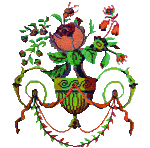

Left hand side : Early XVIIIth century Berlin pattern from A.Philipson. Rigth hand side : Furnishing's silk from Philippe de Lassale from Lyon depicting garland of flower with doves.c.1800
Sheraton's chairs used extansively that brigth covering. He mentioned also in his Dictionary that bed-steps migth be stuffed with hair and covered with some sort of needlework. Following this taste canvas work tends to imatate woven silk using profusly silk as thread and antique symbols and light patterns. Needlewomen therefore turned their attention to appropriate designs and did attempt to stitch them in keeping with the antiquarian mood of the times.
We must notice that it is during the Sheraton period that starts a new trend in needle work : A. Philipson publishes in 1803 a pattern book in Berlin where the patterns is painted on paper. An other Berliner engraver, Frau Wittich, soon led the market in printed patterns which shall be the main feature of a fad called Berlin work during XIXth century for all Europe an America.
REGENCY
The Regency style cover a longer period than the one covering the delegated power to the Prince of Walles.
 Etruria form with scimitar legs mixed with oriental sceneries filling the crest rail and splat. Notice the lion's paw front foot
Etruria form with scimitar legs mixed with oriental sceneries filling the crest rail and splat. Notice the lion's paw front foot
The typical chairs of the Regency period are immediatly recognisable with their shoulder-high square backs, deaped seats and curving scimitar legs. We find too fashion of the late XVIth and late XVIIth century changes in chair design. In main stream the crest rail several inches deep was widened to ride over the uprights instead of being housed between them. Splat begins to be simple horizontal cross rail or diagonal latice and ornament is concentrated on the cresting.
Regency style include structural backward curve of the lower back immediately above the seat rail necessiting then the curving back leg. Front legs are either straight with sometimes a cluster column or most often a variety of Greek leg small at the top, very broad at knee height and tapered.
The classic Greek chair from Roman model is the Regency favourite which continued in post-Regency years. In some late Regency the splat was in the shape of a lyre and the tapering front legs ended in heavy metal paw feet.
 An exotic chair in Brighton house
An exotic chair in Brighton house
Georges IV choice of styles changed from the time he was Prince Regent until he reached the throne. Furniture from these two periods is a blend of styles, and eclectic period. The purchasse of the Parthenon marbles by Lord Elgin created more interest in Greek styles. One used still Egyptian ornamentation on furniture but there was a reccurent interest in things Chinese and revived Gothic style.
For lighter and delicate furniture, the woods used were mahogany, rosewood and satinwood. Nevertheless furniture of this period seems either too light or not enough.
As in Sheraton style needlework with silk thread was still profusly used for chairs covering. The Early XIXth century's liking for pale tones in plain material soon gave place to bright colours. The beginning of the Berlin craze and magazine disseminated designs to a larger segment of the public. Nineteenth and early century patterned needle work was until then the almost only choice for embroidery. Pattern book revolutionizes the market giving a cheap and larger choice of patterns and ornaments. The distinguishable difference between both was that the later were printed on checkered paper with different symbol in the outline of each colours. To the needleworker each square represented a stich. We can said that this was the first ancestor, in hand weaved tapestry field, of the Jean Lurçat method and, in needlework world, the source of the learning process found in the rage of the counted stitch during the last quater of the XXth century.

An example of what has been sold in first printed patterns book. c. 1815
VICTORIAN
The industrial revolution, particularely in weaving labour, introducing the Jacquard loom (1801), realeased women from manufacture at home and thus gave them more time for embroidery. Around 1820s a woven open canvas was developed in France just followed in German. Squarred canvas made it possible so to reproduce patterns printed on squared paper in quickly worked cross-stitch.
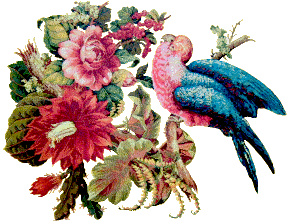
An example of what has been sold in first printed patterns book. c. 1860

Witness of the stylistic uncertainties with some naturalistic influences showed in 1951 to the London's universal exhibition.
Some technique was revisited as appliqué which consisted to stitche a pattern and then sew to dark colored broadcloth. A more complicated technique was to baste canvas over broadcloth with a fine lining material under that, then work the pattern trough the tree layers. When work was finished, the canvas threads was pulled out one by one leaving only the pattern sitting up on the grounds.
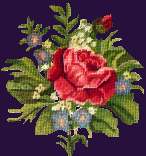
An example of nice bouquet puplished in magazine in 1870
In The Illuminated Book of Needlework published in 1847, Mrs Henry Owen started with the words: Embroidery, or as it is more often called Berlin wool-work. ..
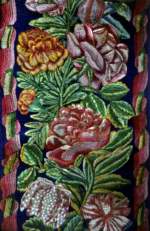 Strip of needlework c.1880
Strip of needlework c.1880